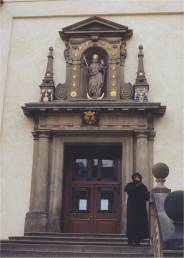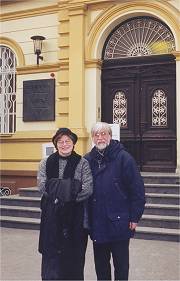| Wenceslas Square is really
not a square at all but is instead a long boulevard that runs uphill from
the Mustek subway stop to the National Museum at the top. Good King
Wenceslas, the patron saint of the country, overlooks the square from horseback
in front of the museum. In more recent years, the square has been the
scene of protests that eventually led to freedom for Czechoslovakia from
the Soviet Union. |
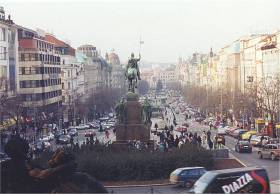
|
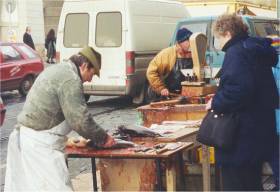
|
Choosing the perfect carp
for Christmas Eve dinner is a shopping tradition in Prague. Large tubs
can be found throughout the city filled with carp for the careful shopper.
After the shopper points out the perfect fish, it is netted, scaled, cleaned,
and wrapped on the spot. Brenda and I had our Christmas Eve dinner
at the Seven Angels and (reluctantly) decided to try the carp. It was
not to our liking. Afterward, we were walking past a restaurant that
had their menu posted in English-- with some interesting results. The
Christmas Eve specialty was listed as "Fried Crap." We decided that
would have probably been about as good as the carp!! |
| Before we left for Prague,
we were a little concerned about what might be open during the Christmas season.
We knew that Prague had an active Christmas Market, but we were led to believe
that it would close on the afternoon of Christmas Eve. We were happy to find
that the information we had was wrong; the market stayed open until late
on Christmas Eve, and most of the booths did not dismantle until late on
December 26th. In addition, we found many of the stores stayed open
throughout the holiday. |
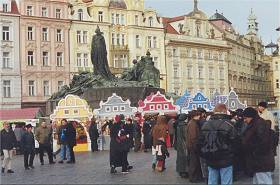
|
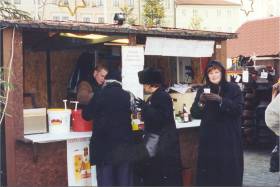
|
By whatever name it's called,
the gluhwein is a delightful addition to Christmas markets throughout Europe.
This hot wine mixture warms the body and the spirit, but the careful shopper
will always seek out the stall that offers the option of a real cup (even
if you have to buy it or leave a deposit.) Too many vendors now offer
it in cheap plastic cups that are impossible to hold even with insulated
gloves. At many of the markets, if you look around you can find it
being sold in souvenir cups-- enjoy your wine and get a nice, cheap souvenir
of your visit. |
| The guards at the castle complex
sometimes seem to be more interested in either (1) eyeing the young girls
that visit the site or (2) planning their evening of revelry at one of the
nearby establishments. The castle complex in Hradcany is only a short
walk from the Domus Henrici, so we actually visited it on several occasions.
The sites that are of most interest to the visitor are the Cathedral (with
its stained glass window by Mucha), the palace interior (where one can
visit the site of the Defenestration of Prague), and the Golden Lane with
its dozens of little shops. |

|
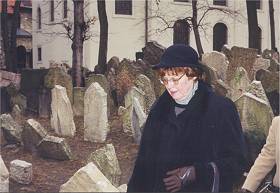
|
Wittmann Tours offers one
of the best tours of the city with the walking tour of the Jewish quarter
of the city (Josefov). The Old Jewish Cemetery is one of the
most remarkable sites in this part of the city. For more than 300 years
beginning in 1478, this was the only available burial space for Prague's
Jews, so people were buried on top of each other as many as twelve deep.
More than 12,000 gravestones are crammed into the tiny space, but more than
100,000 people are probably buried here. |
